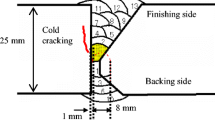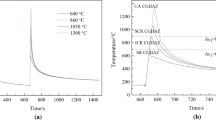Abstract
Brittle crack-arrest fracture toughness \((\hbox {K}_{\mathrm{Ia}})\) was determined in low (1.5 kJ/mm) and high (53 kJ/mm) heat-input weld specimens with a large scale (\(1\times 1\) m) and thickness (50 and 80 mm). An instant impact having energy of 2.7 kJ was imposed into the full-thickness notch tip at low temperature and initiates crack propagation toward a higher temperature region where the crack stopped due to the improved fracture toughness. The relationship between the toughness and crack-arrest temperature provides the \(\hbox {K}_{\mathrm{Ia}}\) at \({-}10\,^{\circ }\hbox {C}\) of about 2700 and \(2200\,\hbox {N/mm}^{3/2}\) in the low and high heat-input weld specimens, respectively. This discrepancy was correlated to the grain size and Charpy impact energy of the notch region caused by the amounts of heat inputs in each weld specimen.






Similar content being viewed by others

References
An GB, Woo W, Park JU (2014) Brittle crack-arrest fracture toughness in a high heat-input thick steel weld. Int J Fract 185:179–185
Bass BR, Williams PT, Pugh CE (2005) An updated correlation for crack-arrest fracture toughness for nuclear reactor pressure vessel steels. Int J Press Vessel Pip 82:489–495
Bezensek B, Hancock JW (2007) The toughness of laser welded joints in the ductile–brittle transition. Eng Fract Mech 74:2395–2419
Feely FJ, Hrkto D, Kleppe SR, Northrup MS (1954) Report on brittle fracture studies. Weld J 33:99s–111s
Inoue T, Ishikawa T, Imai S, Koseki T, Hirota K, Tada M et al (2007) Long crack arrestability of heavy-thick shipbuilding steels. In: Proceedings of the 17th international offshore and polar engineering conference (ISOPE), Lisbon, Portugal
International Association of Classification Societies (IACS) (2013) Rule requirements for use of extremely thick steel plates, s33
Mahmoudi AH, Truman CE, Smith DJ (2008) Using local out-of-plane compression (LOPC) to study the effects of residual stress on apparent fracture toughness. Eng Fract Mech 75:1516–1534
Masubuchi K (1980) Fracture toughness. In: Hopkins DW (ed) Analysis of welded structures. Pergamon, New York, pp 336–378
Priest AH (1998) An energy balance in crack propagation and arrest. Eng Fract Mech 61:231–251
Priest AH (2003) The influence of structural dimensions on crack arrest. Eng Fract Mech 70:2421–2437
Pugh CE, Corwin WR, Bryan RH, Bass BR (1986) Some advances in fracture studies under the heavy-section steel technology program. Nucl Eng Des 96:279–312
Ripling EJ, Crosley PB (1982) Crack arrest fracture toughness of a structure steel (A36). Weld Res 3:65s–74s
Roberson TS (1951) Brittle fracture of mild steel. Engineering 172:444
Smedley GP (1989) Prediction and specification of crack arrest properties of steel pipe. Int J Press Vessel Pip 40:279–302
Sumi Y (1990) Computational crack path prediction for brittle fracture in welding residual streee fields. Int J Fract 44:189–207
Woo W, An GB, Kingston EJ, DeWald AT, Smith DJ, Hill MR (2013) Through-thickness distributions of residual stresses in two extreme heat-input thick welds: A neutron diffraction, contour method and deep hole drilling study. Acta Mater 61:3564–3574
Acknowledgments
This research activity was supported by POSCO Project No. 20126193. The authors would like to thank D. Smith, M. Hill, M. H. Kang, and J. W. Lee for their help.
Author information
Authors and Affiliations
Corresponding author
Rights and permissions
About this article
Cite this article
An, G.B., Woo, W., Park, J.U. et al. Comparison of crack-arrest fracture toughness between low and high heat-input thick weld specimens. Int J Fract 194, 197–203 (2015). https://doi.org/10.1007/s10704-015-0041-2
Received:
Accepted:
Published:
Issue Date:
DOI: https://doi.org/10.1007/s10704-015-0041-2



